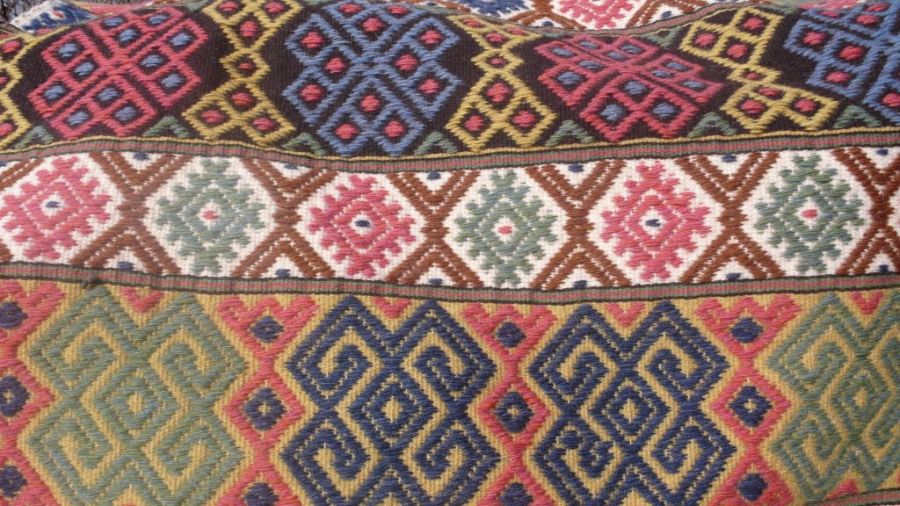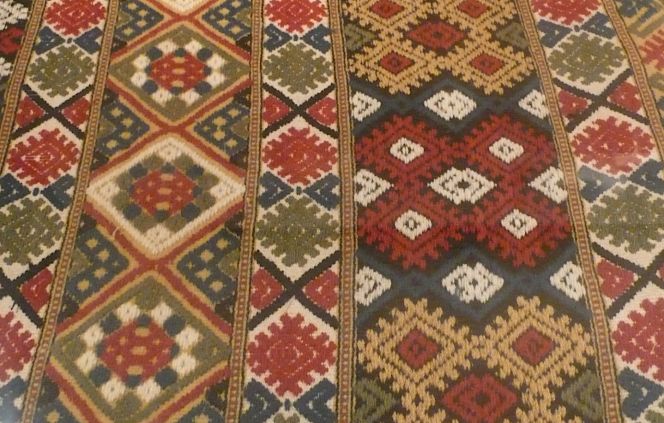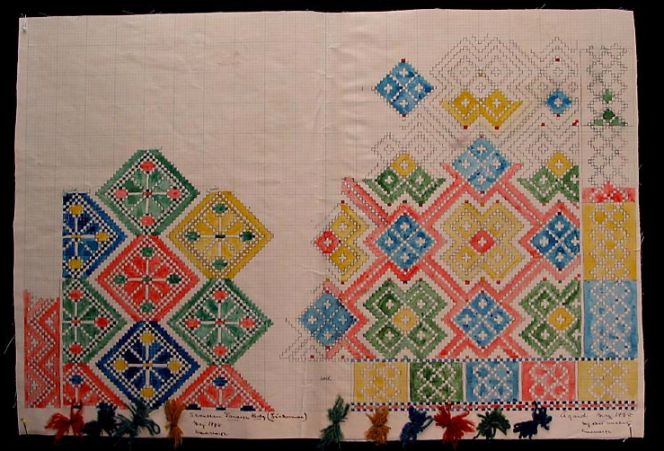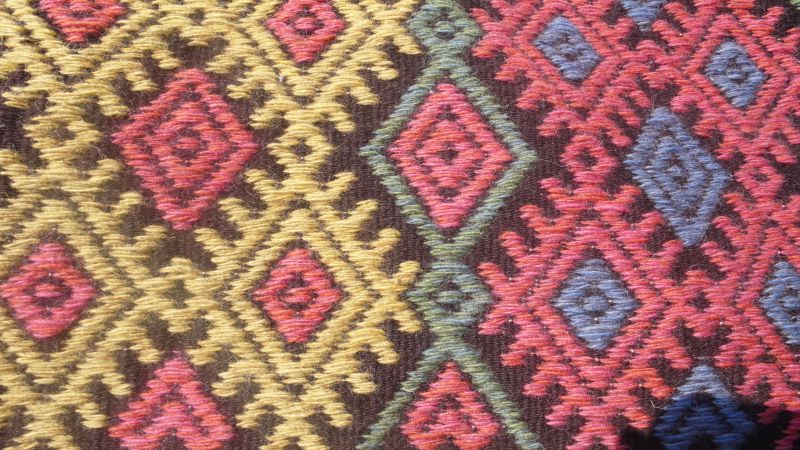ikfoundation.org
The IK Foundation
Promoting Natural & Cultural History
Since 1988


 Crowdfunding Campaign
Crowdfunding Campaignkeep knowledge open, connected, and growing on this textile history resource...
HISTORICAL REPRODUCTIONS
– A Swedish Weaving Tradition
Brocaded tabby type “krabbasnår” was just one of several decorative weaving techniques made by the farmer’s wives in southernmost Sweden during the 18th and 19th centuries. Such a technique in itself is relatively uncomplicated, but the brocading weft pattern picked by hand alternating with the shuttled weft-faced tabby gives the weave a certain complexity. The aim of this historical essay is to share my experience of reproducing one of these beautiful decorative textiles, one which can be compared with an original bench cover and an almost hundred-year-old workshop drawing.
 Historical reproduction of a bench cover in brocaded tabby type “krabbasnår” originating from Herrestads district, Skåne, Sweden. Photo and woven fabric (in full size, 63cm x 120cm): Viveka Hansen.
Historical reproduction of a bench cover in brocaded tabby type “krabbasnår” originating from Herrestads district, Skåne, Sweden. Photo and woven fabric (in full size, 63cm x 120cm): Viveka Hansen.This time-consuming weaving technique was popular in many areas of Sweden and often had various local names, but in the southernmost part of the country, this form of brocaded tabby came to be known as “krabbasnår”. The textiles were primarily woven by farmer’s wives and daughters for the young girl’s dowry or simply as decorative or functional additions to the homes’ textile storage. The uses for these woven treasures included diverse kinds of cushions alongside bench and bed covers – where usually the richly formed patterns almost covered the main weft. These interior textiles were woven in a variation of borders but always in a symmetrical design consisting of shapes like stars, squares, hearts and hourglasses. Besides these facts, during the 1930s excavation of Birka (close to Stockholm), the late textile historian Agnes Geijer established that wool textiles of a similar technical nature had been woven in Sweden as far back as the 10th century.
 Early 19th century ‘krabbasnår’ showing similar type of motifs from south eastern Skåne – exhibited at Kulturen in Lund, Sweden. The museum’s textile gallery displays among its many fabric qualities, embroideries and lacework also a selection of local weaving techniques; where the illustrated example was studied during 2014. Photo: Viveka Hansen.
Early 19th century ‘krabbasnår’ showing similar type of motifs from south eastern Skåne – exhibited at Kulturen in Lund, Sweden. The museum’s textile gallery displays among its many fabric qualities, embroideries and lacework also a selection of local weaving techniques; where the illustrated example was studied during 2014. Photo: Viveka Hansen. Workshop drawing of brocaded tabby type “krabbasnår”, produced by Svensk Hemslöjd (Swedish Handcraft) Stockholm in 1928. This early 20th century drawing with design and chosen colours also mentions a very exact geographical location – Fårarp village, Hoby parish, Ingelstad district, Skåne, Sweden. (Courtesy of: Nordic Museum, Stockholm, NM.0323494, & historical facts from catalogue card. Creative Commons).
Workshop drawing of brocaded tabby type “krabbasnår”, produced by Svensk Hemslöjd (Swedish Handcraft) Stockholm in 1928. This early 20th century drawing with design and chosen colours also mentions a very exact geographical location – Fårarp village, Hoby parish, Ingelstad district, Skåne, Sweden. (Courtesy of: Nordic Museum, Stockholm, NM.0323494, & historical facts from catalogue card. Creative Commons).The reproduction of a “krabbasnår” bench cover has been made using the traditional methods and materials of the 18th and 19th centuries, which entails using a loom with a horizontal linen warp. The weft, comprised of one-ply woollen yarn, was used as a single thread in the shuttle for the main weft, while three threads were used simultaneously in the brocading weft to reach the desired effect of creating a distinctive pattern. Creating this richly patterned technique requires great precision, a fact which is accentuated by the fact that the weaving process is also made more difficult when the weaver has the weave’s back towards her/him in the loom. Furthermore, each change of colour in the pattern must be picked by hand with its small spools of wool, which, in this case, meant up to 35 colour changes/spools of wool used simultaneously on a 60 cm width of the fabric. Please see the three illustrations below for more details of the reproduction attempt.
 Close-up from the reproduction demonstrating how the colours for the ornamentation – here red, yellow, green and blue – were used simultaneously on the dark brown main weft-faced tabby. Photo and woven fabric: Viveka Hansen.
Close-up from the reproduction demonstrating how the colours for the ornamentation – here red, yellow, green and blue – were used simultaneously on the dark brown main weft-faced tabby. Photo and woven fabric: Viveka Hansen. The close-up of the back, showing that the ends of the yarn for the ornamentations are not attached to the fabric, but instead a couple of centimetres of each yarn is left – both on this reproduction like the original 18th and 19th century originals. Photo and woven fabric: Viveka Hansen.
The close-up of the back, showing that the ends of the yarn for the ornamentations are not attached to the fabric, but instead a couple of centimetres of each yarn is left – both on this reproduction like the original 18th and 19th century originals. Photo and woven fabric: Viveka Hansen. The last close-up shows the differences in appearance between the back and front of the reproduction. Photo and woven fabric: Viveka Hansen.
The last close-up shows the differences in appearance between the back and front of the reproduction. Photo and woven fabric: Viveka Hansen.Sources:
- DigitaltMuseum (several examples of ‘krabbasnår’ from southernmost Sweden).
- Hansen, Viveka (Historical reproduction/weaving of “krabbasnår”).
- Nylén, Anna-Maja, Swedish Handcraft, 1976.
- Walterstorff, Emelie von, Svenska vävnadstekniker och mönstertyper, 1940.
Essays
The iTEXTILIS is a division of The IK Workshop Society – a global and unique forum for all those interested in Natural & Cultural History.
Open Access Essays by Textile Historian Viveka Hansen
Textile historian Viveka Hansen offers a collection of open-access essays, published under Creative Commons licenses and freely available to all. These essays weave together her latest research, previously published monographs, and earlier projects dating back to the late 1980s. Some essays include rare archival material — originally published in other languages — now translated into English for the first time. These texts reveal little-known aspects of textile history, previously accessible mainly to audiences in Northern Europe. Hansen’s work spans a rich range of topics: the global textile trade, material culture, cloth manufacturing, fashion history, natural dyeing techniques, and the fascinating world of early travelling naturalists — notably the “Linnaean network” — all examined through a global historical lens.
Help secure the future of open access at iTEXTILIS essays! Your donation will keep knowledge open, connected, and growing on this textile history resource.
been copied to your clipboard




– a truly European organisation since 1988
Legal issues | Forget me | and much more...
You are welcome to use the information and knowledge from
The IK Workshop Society, as long as you follow a few simple rules.
LEARN MORE & I AGREE







